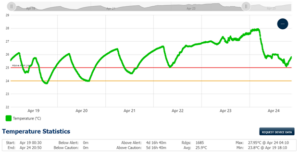Thermal or temperature probe buffering is a common practice utilized to prevent false triggers due to temperature excursions. These excursions may occur as a result of several factors –
- The temperature cycling of the storage unit
- The sudden inclusion of additional goods into the storage unit
- More often the result of an inrush of warm air when the storage unit door is opened
Each of these can cause a temperature change that may result in an alert condition. Thus, a physical buffer is utilized to dampen temperature fluctuations.
In previous posts from this blog series, the guidance provided by the Centers for Disease Control and Prevention (CDC) was cited. Herein again, the CDC recommends the use of Buffered Temperature Probe, however, little specification is provided. From the CDC Vaccine Handling Took Kit, the following is presented:
“Many DDLs (Digital Data Logger) use a buffered temperature probe, which is the most accurate way to measure actual vaccine temperatures. Temperatures measured by a buffered probe match vaccine temperatures more closely than those measured by standard thermometers, which tend to reflect only air temperature.”
Absent from the CDC Guidance is any direction of buffer size. The graphic below demonstrates the effect of the buffer based on the volume of the reservoir versus the air temperature. Figures 1a and 1b below demonstrates the temperature change versus time for common size volume buffers. Figure 1a demonstrates the effect of warming temperatures, whileFigure 1b is that of cooling temperatures.

Figure 1a – Buffer Size Comparison – Warming

The intent of the buffer is to accurately represent the temperature of the stored good; when considering the volume of the buffer, it is of utmost importance to consider matching the volume of the stored good; the “protection” against false readings will follow. The challenge, however, is to ensure that the stored goods are not compromised due to over buffering.
The CDC Guidance explains the purpose of the buffer as well as the buffer material. Further quoting the CDC Handbook:
“Temperature probe designed to prevent false readings by protecting the thermometer from sudden changes in temperature that can occur when opening a refrigerator door. A probe is “buffered” by immersing it in a vial filled with liquid (e.g., glycol, ethanol, glycerin), loose media (e.g., sand, glass beads), or a solid block of material (e.g., Teflon®, aluminum)”.
The objective of matching the stored good most closely, the volume and material selected as the buffer is critical. It may be intuitive to select a buffer volume of 20 ml, as this most closely represents the volume of the stored good. Following the CDC Guidance for the buffer material, further consideration as to the volume of the buffer material utilized. The closest representative material to a stored liquid is a liquid-filled vial utilizing glycol, ethanol or glycerin[1].
The solid materials recommended by the CDC offer options that do not spill or evaporate while in use, thus a viable alternative to the liquid solution. When considering the use of any buffer the volume utilized in paramount. This is especially true when using a solid buffer. Each of the materials noted by the CDC Guidance has different thermal properties. That is, the same volume of Teflon™, aluminum, glass beads or sand do not have the same thermal response. This is demonstrated in the graphic in Figure 2.


This graphic demonstrates that the selected materials respond more rapidly than that of the liquid buffers. This demonstrates that there is not a one-to-one correlation of the solid buffer to the liquid. The consequence of any physical buffer, that object must place such that it is not interfered with by the contents while continuing to be placed in the center of mass of the storage unit.
What we are experiencing here is a convergence of requirements without specification. Given the lack of specificity of the CDC Guidance, the selection of the buffer size and material is left to the end-user. Herein, the end-user will turn to the supplier of the temperature monitor solution to provide the “correct” product for the application.
Given the above, it is evident that there is not a one-size-fits-all solution. To best address, this problem, the engineers at PharmaWatch™ have developed a patented methodology to deliver a buffered temperature via a mathematical model using the measured air temperature. This solution is referred to as Virtual Temperature Buffering (VTB)™. The virtual temperature buffered value is computed from the air temperature using separate and distinct constants into the model for each volume and geometry of the stored good. That is, from the air temperature data stream, the temperature of the contents can be modeled without altering the air temperature data. The graphic results are show below in Figure 3.

Figure 3 – VTB™ Example
The data analytics can aid the content supplier to determine the viability of the stored good in the event of a temperature excursion. This can be applied to any volume and geometry in the storage unit. By understanding the temperature impact, better decision making as to the disposition of the contents can be made. The end-user is the ideal person to assess the effects of improper storage conditions. The effects upon pharmaceuticals can be easily researched, demonstrated and measured. Damage to tissue or other materials is best assessed by the end-user.
This formula was tested by comparing the theoretical data using VTB™ equation and physical glycol buffering of the same size. The result was as the model predicted; the error was observed to be +5% / -3%. Demonstrated in an independent study, the accurate derivation of the constant ƙ results in a much more accurate representation of the temperature of the stored contents with an error of 0.5%. With the ability to represent the temperature of the stored goods, while providing an equivalency of buffering the air temperature, it is no longer necessary to utilize a physical buffer. The recorded raw air temperature can be acted upon providing data that would be otherwise masked by a buffered temperature. Herein, the above algorithm and appropriate constants can be utilized to replace physical buffering, matching the contents of the storage unit to the buffering algorithm.
[1] These materials are chosen over water to protect against freezing.



